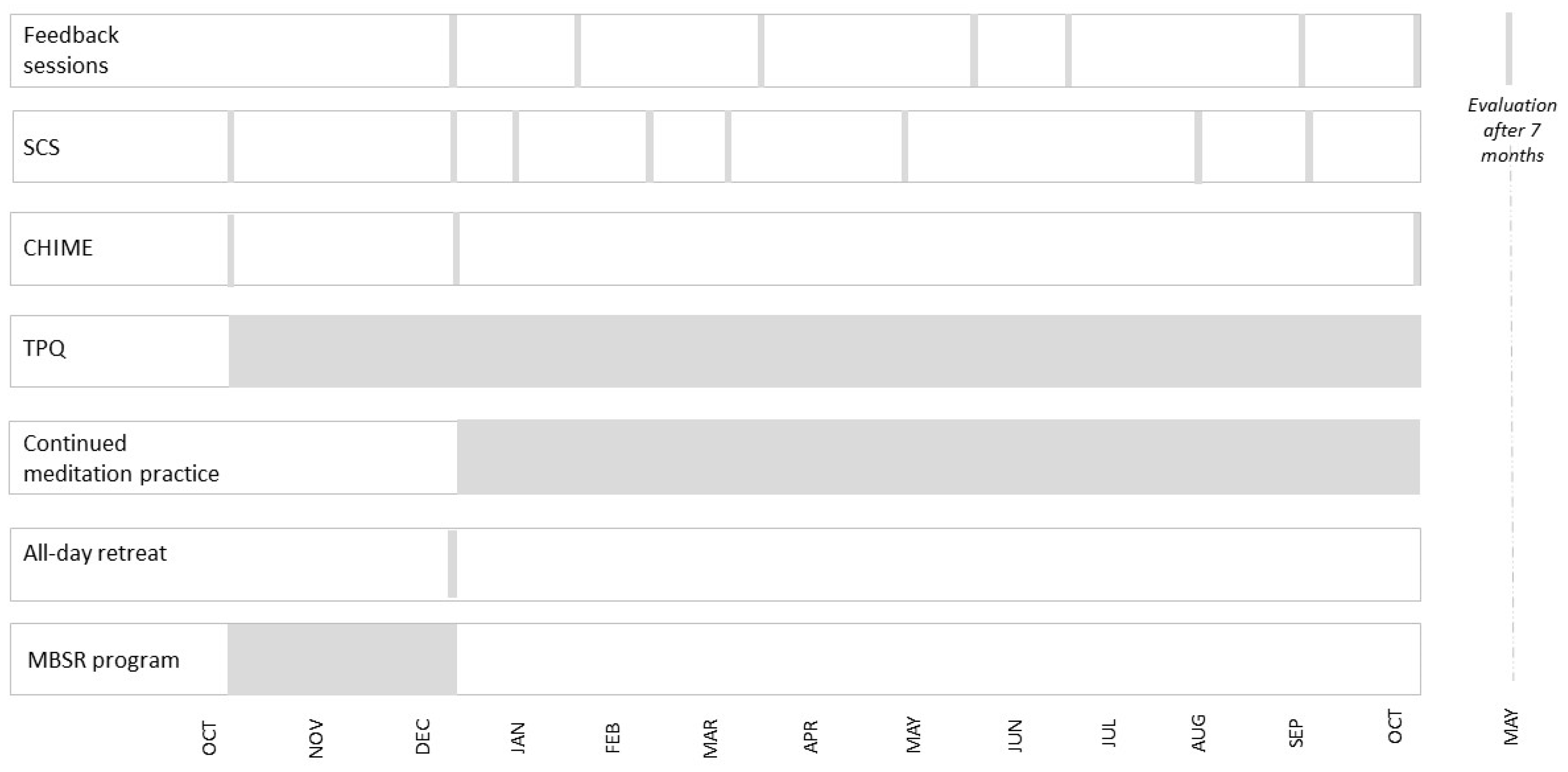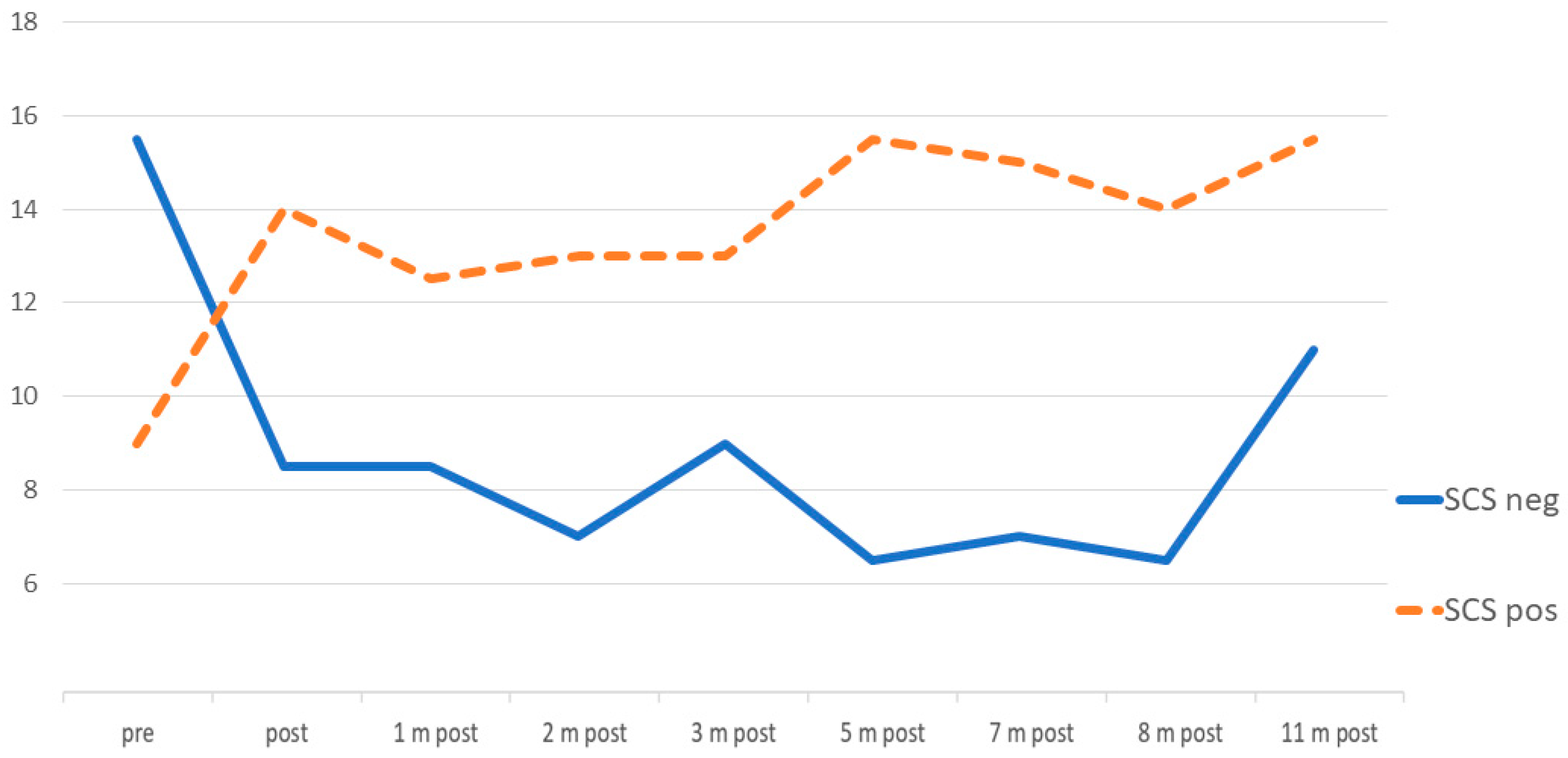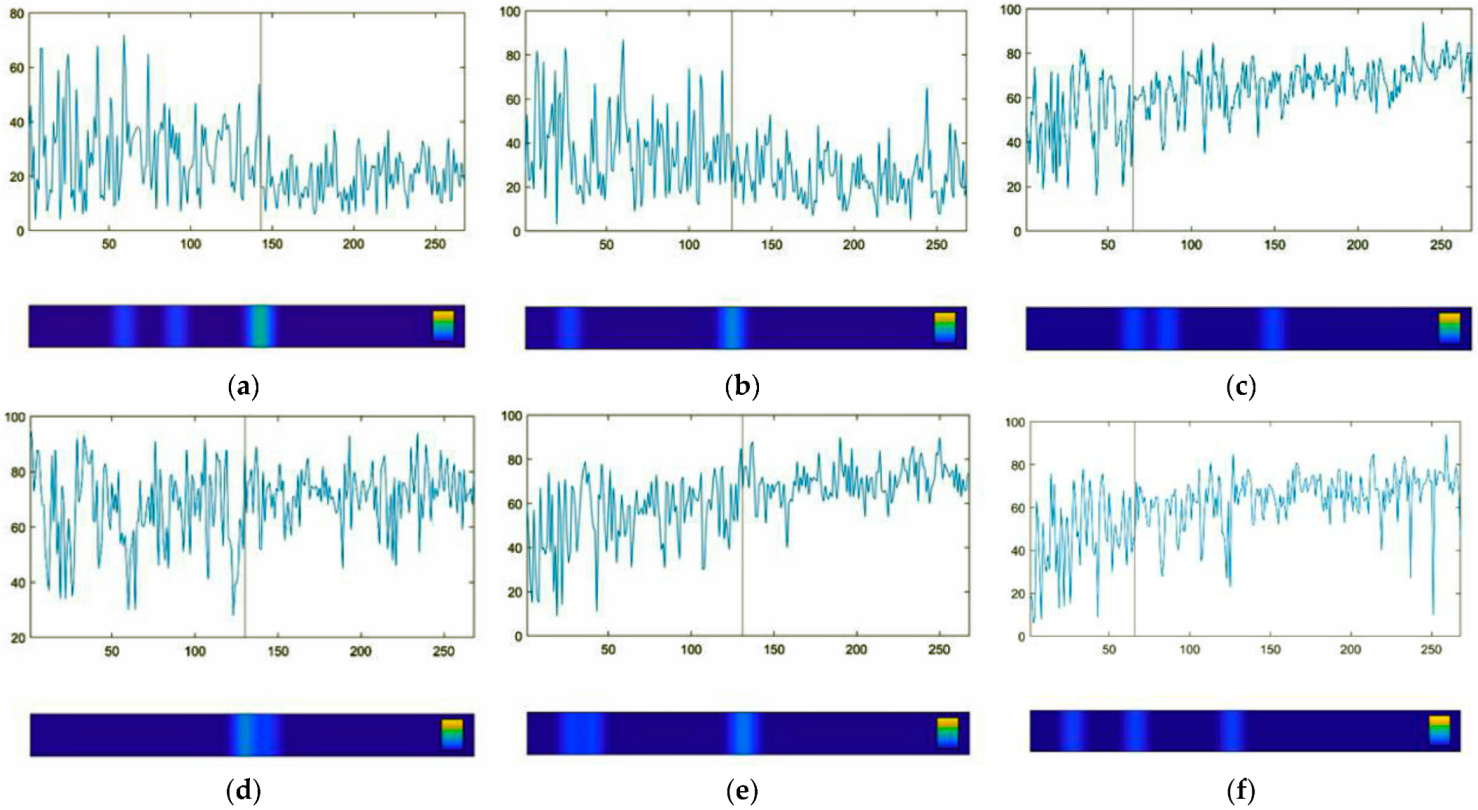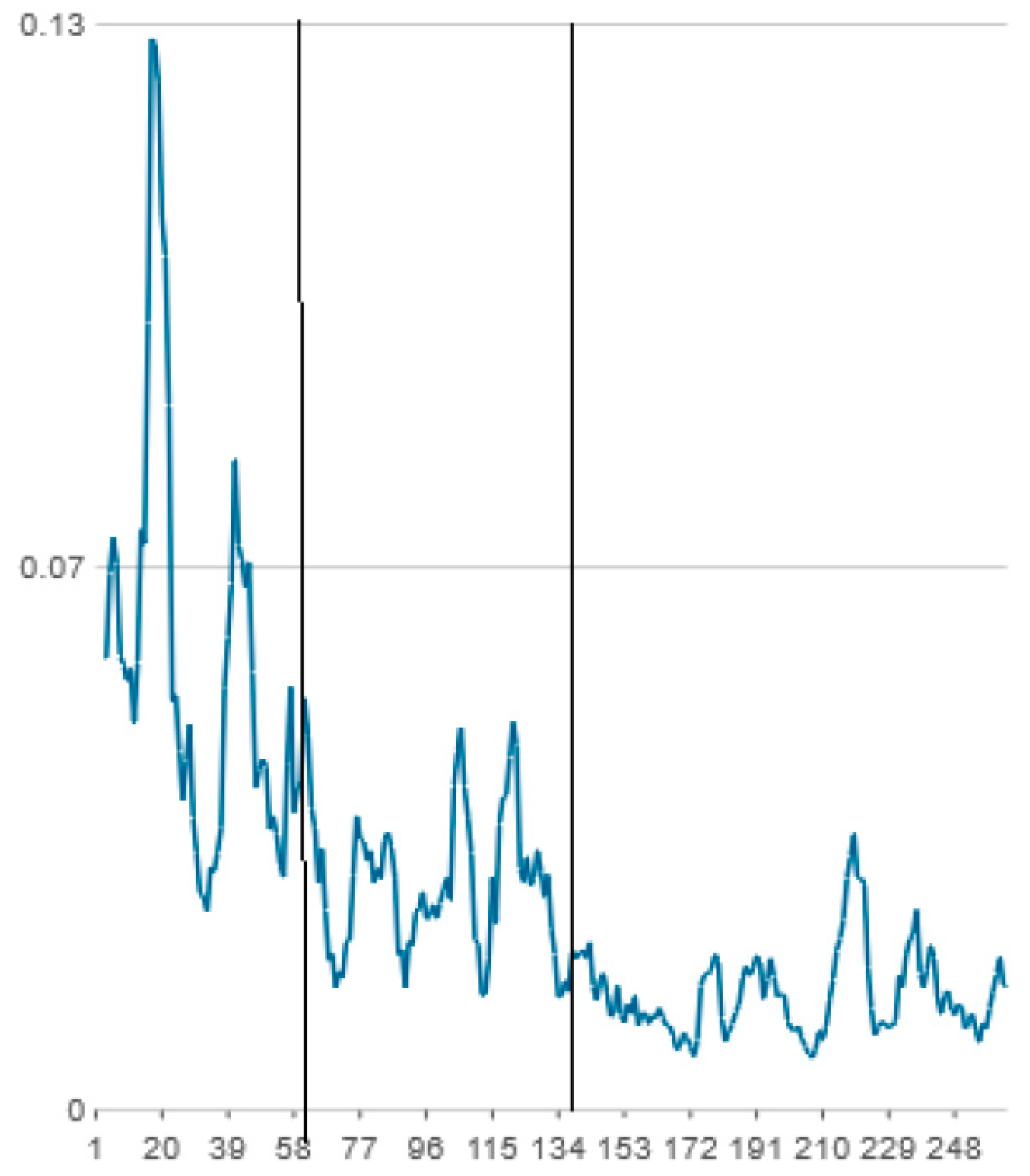Features of Self-Organization during the Process of Mindfulness-Based Stress Reduction: A Single Case Study
Abstract
1. Introduction
2. Materials and Methods
2.1. Participant
2.2. Procedure
2.3. Measures
2.4. Data Analysis
3. Results
4. Discussion
4.1. Dynamics of Mindfulness-Based Interventions as a Self-Organizing Process
4.2. Continuous Assessment and Systematic Feedback Support the Change Process
4.3. Feasibility of High-Frequency Process-Monitoring and Process-Feedback
4.4. Limitations
4.5. Perspectives
Author Contributions
Funding
Institutional Review Board Statement
Data Availability Statement
Conflicts of Interest
References
- Goldberg, S.B.; Tucker, R.P.; Greene, P.A.; Davidson, R.J.; Wampold, B.E.; Kearney, D.J.; Simpson, T.L. Mindfulness-based interventions for psychiatric disorders: A systematic review and meta-analysis. Clin. Psychol. Rev. 2018, 59, 52–60. [Google Scholar] [CrossRef]
- Wielgosz, J.; Goldberg, S.B.; Kral, T.R.; Dunne, J.D.; Davidson, R.J. Mindfulness meditation and psychopathology. Ann. Rev. Clin. Psychol. 2019, 15, 285–316. [Google Scholar] [CrossRef]
- Baer, R.A.; Carmody, J.; Hunsinger, M. Weekly change in mindfulness and perceived stress in a mindfulness-based stress reduction program. J. Clin. Psychol. 2012, 68, 755–765. [Google Scholar] [CrossRef]
- Smith, S.A. Mindfulness-based stress reduction: An intervention to enhance the effectiveness of nurses’ coping with work-related stress. Int. J. Nurs. Knowl. 2014, 25, 119–130. [Google Scholar] [CrossRef]
- Schuman-Olivier, Z.; Trombka, M.; Lovas, D.A.; Brewer, J.A.; Vago, D.R.; Gawande, R.; Dunne, J.P.; Lazar, S.W.; Loucks, E.B.; Fulwiler, C. Mindfulness and behavior change. Harv. Rev. Psychiatry 2020, 28, 371–394. [Google Scholar] [CrossRef]
- Butler, L.D.; Mercer, K.A.; McClain-Meeder, K.; Horne, D.M.; Dudley, M. Six domains of self-care: Attending to the whole person. J. Hum. Behav. Soc. Environ. 2019, 29, 107–124. [Google Scholar] [CrossRef]
- Christopher, J.C.; Maris, J.A. Integrating mindfulness as self-care into counselling and psychotherapy training. Couns. Psychother. Res. 2010, 10, 114–125. [Google Scholar] [CrossRef]
- Coaston, S.C. Self-care through self-compassion: A balm for burnout. Prof. Couns. 2017, 7, 285–297. [Google Scholar] [CrossRef]
- Brown, K.W.; Ryan, R.M. The benefits of being present: Mindfulness and its role in psychological well-being. J. Pers. Soc. Psychol. 2003, 84, 822–848. [Google Scholar] [CrossRef]
- Schultz, P.P.; Ryan, R.M. The “why”, “what”, and “how” of healthy self-regulation: Mindfulness and well-being from a self-determination theory perspective. In Handbook of Mindfulness and Self-Regulation; Ostafin, B.D., Robinson, M.D., Meier, B.P., Eds.; Springer: New York, NY, USA, 2015; pp. 81–94. [Google Scholar] [CrossRef]
- Fjorback, L.O.; Arendt, M.; Ornbøl, E.; Fink, P.; Walach, H. Mindfulness-based stress reduction and mindfulness-based cognitive therapy: A systematic review of randomized controlled trials. Acta Psychiatr. Scand. 2011, 124, 102–119. [Google Scholar] [CrossRef]
- Kabat-Zinn, J. An outpatient program in behavioral medicine for chronic pain patients based on the practice of mindfulness meditation: Theoretical considerations and preliminary results. Gen. Hosp. Psychiatry 1982, 4, 33–47. [Google Scholar] [CrossRef]
- Segal, Z.V.; Williams, J.M.; Teasdale, J. Mindfulness-Based Cognitive Therapy for Depression: A New Approach to Preventing Relapse; Guilford Press: New York, NY, USA, 2002. [Google Scholar]
- Kabat-Zinn, J. Some reflections on the origins of MBSR, skillful means, and the trouble with maps. Contemp. Buddhism 2011, 12, 281–306. [Google Scholar] [CrossRef]
- Grossman, P. On the porosity of subject and object in “mindfulness” scientific study: Challenges to “scientific” construction, operationalization and measurement of mindfulness. Curr. Opin. Psychol. 2019, 28, 102–107. [Google Scholar] [CrossRef]
- Bishop, S.R.; Lau, M.; Shapiro, S.; Carlson, L.; Anderson, N.D.; Carmody, J.; Segal, Z.V.; Abbey, S.; Speca, M.; Velting, D.; et al. Mindfulness: A proposed operational definition. Clin. Psychol. Sci. Pract. 2004, 11, 230–241. [Google Scholar] [CrossRef]
- Shapiro, S.L.; Carlson, L.E.; Astin, J.A.; Freedman, B. Mechanisms of mindfulness. J. Clin. Psychol. 2006, 62, 373–386. [Google Scholar] [CrossRef]
- Safran, J.D.; Segal, Z.V. Interpersonal process in cognitive therapy; Rowman & Littlefield: Lanham, MD, USA, 1990. [Google Scholar]
- Bernstein, A.; Hadash, Y.; Lichtash, Y.; Tanay, G.; Shepherd, K.; Fresco, D.M. Decentering and related constructs. A critical review and metacognitive processes model. Perspect. Psychol. Sci. 2015, 10, 599–617. [Google Scholar] [CrossRef]
- Bernstein, A.; Hadash, Y.; Fresco, D.M. Metacognitive processes model of decentering: Emerging methods and insights. Curr. Opin. Psychol. 2019, 28, 245–251. [Google Scholar] [CrossRef]
- Bergomi, C.; Tschacher, W.; Kupper, Z. Measuring mindfulness: First steps towards the development of a comprehensive mindfulness scale. Mindfulness 2013, 4, 18–32. [Google Scholar] [CrossRef]
- Shen, C.Y.; Midgley, G. Toward a buddhist systems methodology 1: Comparisons between buddhism and systems theory. Syst. Pract. Action Res. 2007, 20, 167–194. [Google Scholar] [CrossRef]
- Macy, J. Mutual Causality in Buddhism and General Systems Theory; State University of New York Press: Albany, NY, USA, 1991. [Google Scholar]
- Bertalanffy, L. The theory of open systems in physics and biology. Science 1950, 111, 23–29. [Google Scholar] [CrossRef]
- Haken, H.; Schiepek, G. Synergetik in der Psychologie: Selbstorganisation verstehen und gestalten, 2. Aufl. In Synergetics in Psychology: Understanding and Supporting Self-Organization, 2nd ed.; Göttingen: Hogrefe, Germany, 2010. [Google Scholar]
- Tschacher, W.; Lienhard, N. Mindfulness is linked with affectivity in daily life: An experience-sampling study with meditators. Mindfulness 2021, 12, 1459–1472. [Google Scholar] [CrossRef]
- Erisman, S.M.; Roemer, L. A preliminary investigation of the process of mindfulness. Mindfulness 2012, 3, 30–43. [Google Scholar] [CrossRef]
- Kornfield, J. Intensive insight meditation: A phenomenological study. J. Transpers. Psychol. 1979, 11, 41–58. [Google Scholar]
- Varela, F.J.; Thompson, E.; Rosch, E. The Embodied Mind: Cognitive Science and Human Experience; MIT Press: Cambridge, UK; London, UK, 1991. [Google Scholar]
- Rosch, E. Introduction to the revised Edition. In The Embodied Mind: Cognitive Science and Human Experience, revised ed.; Varela, F.J., Thompson, E., Rosch, E., Eds.; MIT Press: Cambridge, UK; London, UK, 2016; pp. xxxv–lvi. [Google Scholar] [CrossRef]
- Thompson, E. Introduction to the revised Edition. In The Embodied Mind: Cognitive Science and Human Experience, revised ed.; Varela, F.J., Thompson, E., Rosch, E., Eds.; MIT Press: Cambridge, UK; London, UK, 2016; pp. xvii–xxxiii. [Google Scholar] [CrossRef]
- Haken, H. Synergetics. In Introduction and Advanced Topics; Springer: Berlin/Heidelberg, Germany, 2004. [Google Scholar]
- Suelmann, H.; Brouwers, A.; Snippe, E. Explaining variations in mindfulness levels in daily life. Mindfulness 2018, 9, 1895–1906. [Google Scholar] [CrossRef]
- Andreotti, E.; Congard, A.; Le Vigouroux, S.; Dauvier, B.; Illy, J.; Poinsot, R.; Antoine, P. Rumination and mindlessness processes: Trajectories of change in a 42-day mindfulness-based intervention. J. Cogn. Psychother. 2018, 32, 127–139. [Google Scholar] [CrossRef]
- Aizik-Reebs, A.; Shoham, A.; Hadash, Y.; Bernstein, A. A network modeling approach to mindfulness mechanisms: A proof-of-concept investigation. Mindfulness 2021, 12, 1115–1126. [Google Scholar] [CrossRef]
- Schiepek, G.; Gelo, O.; Viol, K.; Kratzer, L.; Orsucci, F.; de Felice, G.; Stöger-Schmidinger, B.; Sammet, I.; Aichhorn, W.; Schöller, H. Complex individual pathways or standard tracks? A data-based discussion on the trajectories of change in psychotherapy. Couns. Psychother. Res. 2020, 20, 689–702. [Google Scholar] [CrossRef]
- Olthof, M.; Hasselman, F.; Strunk, G.; van Rooij, M.; Aas, B.; Helmich, M.A.; Schiepek, G.; Lichtwarck-Aschoff, A. Critical fluctuations as an early-warning signal for sudden gains and losses in patients receiving psychotherapy for mood disorders. Clin. Psychol. Sci. 2019, 8, 22–35. [Google Scholar] [CrossRef]
- Molenaar, P.C.M. On the necessity to use person-specific data analysis approaches in psychology. Europ. J. Develop. Psychol. 2013, 10, 29–39. [Google Scholar] [CrossRef]
- Hayes, A.M.; Laurenceau, J.-P.; Feldman, G.; Strauss, J.L.; Cardaciotto, L. Change is not always linear: The study of nonlinear and discontinuous patterns of change in psychotherapy. Clin. Psychol. Rev. 2007, 27, 715–723. [Google Scholar] [CrossRef]
- Westerman, M.A. What can we learn from case studies? More than most psychologists realize. Pragmat. Case Stud. Psychother. 2009, 5, 53–70. [Google Scholar] [CrossRef][Green Version]
- Viol, K.; Schöller, H.; Kaiser, A.; Fartacek, C.; Aichhorn, W.; Schiepek, G. Detecting pattern transitions in psychological time series—A validation study on the pattern transition detection algorithm (PTDA). PLoS ONE 2022, 17, e0265335. [Google Scholar] [CrossRef] [PubMed]
- Kabat-Zinn, J. Full catastrophe living. In Using the Wisdom of Your Body and Mind to Face Stress, Pain, and Illness; Bantam Books: New York, NY, USA, 1990. [Google Scholar]
- Santorelli, S.F. Remembrance: Dialogue and inquiry in the MBSR classroom. In Resources for Teaching Mindfulness; McCown, D., Reibel, D., Micozzi, M.S., Eds.; Springer: Cham, Switzerland, 2016; pp. 47–68. [Google Scholar] [CrossRef]
- Schiepek, G.; Stöger-Schmidinger, B.; Kronberger, H.; Aichhorn, W.; Kratzer, L.; Heinz, P.; Viol, K.; Lichtwarck-Aschoff, A.; Schöller, H. The therapy process questionnaire. Factor analysis and psychometric properties of a multidimensional self-rating scale for high-frequency monitoring of psychotherapeutic processes. Clin. Psychol. Psychother. 2019, 26, 586–602. [Google Scholar] [CrossRef] [PubMed]
- Raes, F.; Pommier, E.; Neff, K.D.; van Gucht, D. Construction and factorial validation of a short form of the self-compassion scale. Clin. Psychol. Psychother. 2011, 18, 250–255. [Google Scholar] [CrossRef] [PubMed]
- Hupfeld, J.; Ruffieux, N. Validierung einer deutschen Version der Self-Compassion Scale (SCS-D). Z. Klin. Psychol. Psychother. 2011, 40, 115–123. [Google Scholar] [CrossRef]
- Coroiu, A.; Kwakkenbos, L.; Moran, C.; Thombs, B.; Albani, C.; Bourkas, S.; Zenger, M.; Brahler, E.; Körner, A. Structural validation of the self-compassion scale with a german general population sample. PLoS ONE 2018, 13, e0190771. [Google Scholar] [CrossRef]
- Schiepek, G.; Strunk, G. The identification of critical fluctuations and phase transitions in short term and coarse-grained time series—A method for the real-time monitoring of human change processes. Biol. Cybern. 2010, 102, 197–207. [Google Scholar] [CrossRef]
- Marwan, N.; Romano, M.C.; Thiel, M.; Kurths, J. Recurrence plots for the analysis of complex systems. Phys. Rep. 2007, 438, 237–329. [Google Scholar] [CrossRef]
- Webber, C.L.; Marwan, N., Jr. Recurrence Quantification Analysis: Theory and Best Practices; Springer: Cham, Switzerland, 2015. [Google Scholar]
- Schiepek, G.; Schöller, H.; de Felice, G.; Steffensen, S.V.; Skaalum Bloch, M.; Fartacek, C.; Aichhorn, W.; Viol, K. Convergent validation of methods for the identification of phase transitions in time series of empirical and model systems. Front. Psychol. 2020, 11, 1970. [Google Scholar] [CrossRef]
- Killick, R.; Fearnhead, P.; Eckley, I.A. Optimal detection of change points with a linear computational cost. J. Am. Stat. Assoc. 2012, 107, 1590–1598. [Google Scholar] [CrossRef]
- Cohen, L. Time-frequency distributions. A review. Proc. IEEE 1989, 77, 941–981. [Google Scholar] [CrossRef]
- Sundar, A. Time Frequency Distribution of a Signal Using S-Transform (Stockwell Transform). MATLAB Central File Exchange. 2023. Available online: https://www.mathworks.com/matlabcentral/fileexchange/51808-time-frequency-distribution-of-a-signal-using-s-transform-stockwell-transform (accessed on 18 May 2023).
- Kriakous, S.A.; Elliott, K.A.; Lamers, C.; Owen, R. The effectiveness of mindfulness-based stress reduction on the psychological functioning of healthcare professionals: A systematic review. Mindfulness 2021, 12, 1–28. [Google Scholar] [CrossRef] [PubMed]
- Grabovac, A. The stages of insight: Clinical relevance for mindfulness-based interventions. Mindfulness 2015, 6, 589–600. [Google Scholar] [CrossRef]
- Analayo. Satipatthana. The Direct Path to Realization; Windhorse: Birmingham, UK, 2003. [Google Scholar]
- Wampold, B.E.; Imel, Z.E. The Great Psychotherapy Debate: The Evidence for What Makes Psychotherapy Work, 2nd ed; Routledge: New York, NY, USA, 2015. [Google Scholar]
- Schiepek, G.; Viol, K.; Aichhorn, W.; Hütt, M.T.; Sungler, K.; Pincus, D.; Schöller, H. Psychotherapy is chaotic—(not only) in a computational world. Front. Psychol. 2017, 8, 379. [Google Scholar] [CrossRef] [PubMed]
- Schöller, H.; Viol, K.; Aichhorn, W.; Hütt, M.T.; Schiepek, G. Personality development in psychotherapy: A synergetic model of state-trait dynamics. Cogn. Neurodyn. 2018, 12, 441–459. [Google Scholar] [CrossRef] [PubMed]
- Bovendeerd, B.; de Jong, K.; de Groot, E.; Moerbeek, M.; de Keijser, J. Enhancing the effect of psychotherapy through systematic client feedback in outpatient mental healthcare: A cluster randomized trial. Psychother. Res. 2022, 32, 710–722. [Google Scholar] [CrossRef] [PubMed]
- Schiepek, G.; Eckert, H.; Aas, B.; Wallot, S.; Wallot, A. Integrative Psychotherapy: A Feedback-Driven Dynamic Systems Approach; Hogrefe Publishing: Oxford, UK, 2015. [Google Scholar] [CrossRef]
- Brattland, H.; Koksvik, J.M.; Burkeland, O.; Klöckner, C.A.; Lara-Cabrera, M.L.; Miller, S.D.; Wampold, B.; Ryum, T.; Iversen, V.C. Does the working alliance mediate the effect of routine outcome monitoring (ROM) and alliance feedback on psychotherapy outcomes? A secondary analysis from a randomized clinical trial. J. Couns. Psychol. 2019, 66, 234–246. [Google Scholar] [CrossRef]
- Bordin, E.S. The generalizability of the psychoanalytic concept of the working alliance. Psychother. Theor. Res. Pract. 1979, 16, 252–260. [Google Scholar] [CrossRef]
- Wampold, B.E. How important are the common factors in psychotherapy? An update. World Psychiatry 2015, 14, 270–277. [Google Scholar] [CrossRef]
- Dahl, C.J.; Lutz, A.; Davidson, R.J. Reconstructing and deconstructing the self: Cognitive mechanisms in meditation practice. Trends Cogn. Sci. 2015, 19, 515–523. [Google Scholar] [CrossRef]
- Blanke, E.S.; Schmidt, M.J.; Riediger, M.; Brose, A. Thinking mindfully: How mindfulness relates to rumination and reflection in daily life. Emotion 2020, 20, 1369–1381. [Google Scholar] [CrossRef] [PubMed]
- Michaelis, R.; Edelhäuser, F.; Hülsner, Y.; Trinka, E.; Viol, K.; Schiepek, G. High frequency monitoring of personalized psychological variables during outpatient psychotherapy in people with seizures: An uncontrolled feasibility study. Epilepsy Behav. 2021, 122, 108119. [Google Scholar] [CrossRef] [PubMed]
- de Jong, K.; Conijn, J.M.; Gallagher, R.A.V.; Reshetnikova, A.S.; Heij, M.; Lutz, M.C. Using progress feedback to improve outcomes and reduce drop-out, treatment duration, and deterioration: A multilevel meta-analysis. Clin. Psychol. Rev. 2021, 85, 102002. [Google Scholar] [CrossRef] [PubMed]
- Delgadillo, J.; Overend, K.; Lucock, M.; Groom, M.; Kirby, N.; McMillan, D.; Gilbody, S.; Lutz, W.; Rubel, J.A.; de Jong, K. Improving the efficiency of psychological treatment using outcome feedback technology. Behav. Res. Ther. 2017, 99, 89–97. [Google Scholar] [CrossRef]
- Shimokawa, K.; Lambert, M.J.; Smart, D.W. Enhancing treatment outcome of patients at risk of treatment failure: Meta-analytic and mega-analytic review of a psychotherapy quality assurance system. J. Consult. Clin. Psychol. 2010, 78, 298–311. [Google Scholar] [CrossRef]
- Lambert, M.J. Maximizing psychotherapy outcome beyond evidence-based medicine. Psychother. Psychosom. 2017, 86, 80–89. [Google Scholar] [CrossRef]
- Wampold, B. Routine outcome monitoring: Coming of age with the usual developmental challenges. Psychotherapy 2015, 52, 458–462. [Google Scholar] [CrossRef]
- McClintock, A.S.; Perlman, M.R.; McCarrick, S.M.; Anderson, T.; Himawan, L. Enhancing psychotherapy process with common factors feedback: A randomized, clinical trial. J. Couns. Psychol. 2017, 64, 247–260. [Google Scholar] [CrossRef]
- Bastiaansen, J.A.; Kunkels, Y.K.; Blaauw, F.J.; Boker, S.M.; Ceulemans, E.; Chen, M.; Chow, S.-M.; de Jonge, P.; Emerencia, A.C.; Epskamp, S.; et al. Time to get personal? The impact of researchers choices on the selection of treatment targets using the experience sampling methodology. J. Psychosom. Res. 2020, 137, 110211. [Google Scholar] [CrossRef]
- Gual-Montolino, P.; Martinez-Borba, V.; Bretón-López, J.M.; Osma, J.; Suso-Ribera, C. How are information and communication technologies supporting routine outcome monitoring and measurement-based care in psychotherapy? A systematic review. Int. J. Environ. Res. Public Health 2020, 17, 3170. [Google Scholar] [CrossRef]
- Molenaar, P.C.M.; Campbell, C.G. The new person-specific paradigm in psychology. Curr. Dir. Psychol. Sci. 2009, 18, 112–117. [Google Scholar] [CrossRef]
- Shrout, P.E.; Stadler, G.; Lane, S.P.; McClure, M.J.; Jackson, G.L.; Clavél, F.D.; Iida, M.; Gleason, M.E.J.; Xu, J.H.; Bolger, N. Initial elevation bias in subjective reports. PNAS Plus 2017, 115, E15–E23. [Google Scholar] [CrossRef]
- Cayoun, B.A. The Clinical Handbook of Mindfulness-Integrated Cognitive Behavior Therapy: A Step-by-Step Guide for Therapists; Wiley-Blackwell: Hoboken, NJ, USA, 2018. [Google Scholar]
- Blanke, E.S.; Brose, A. Mindfulness in daily life: A multidimensional approach. Mindfulness 2017, 8, 737–750. [Google Scholar] [CrossRef]
- Britton, W.B. Can mindfulness be too much of a good thing? The value of a middle way. Curr. Opin. Psychol. 2019, 28, 159–165. [Google Scholar] [CrossRef]
- Reynolds, L.M.; Bissett, I.P.; Porter, D.; Consedine, N.S. A brief mindfulness intervention is associated with negative outcomes in a randomized controlled trial among chemotherapy patients. Mindfulness 2017, 8, 1291–1303. [Google Scholar] [CrossRef]








| Dysphoric Emotions (DE) |
|---|
| Today, I felt joy (r) |
| Today, I experienced moments of happiness and lightheartedness (r) |
| Today, my self-esteem was … (r) |
| Today, I felt anxious |
| Today, I felt sad |
| Today, I felt guilty |
| Today, I felt angry |
| Today, I felt shame |
| Insight/new perspectives (INP) |
| Today, I became aware of relations that were not clear to me before |
| Today, I worked on things that were new and unusual for me |
| Today, I had new insights about how to better deal with my life circumstances |
| Today, I gained insight into how my thoughts, feelings, and behavior influence each other |
| I now understand myself and my problems better |
| Awareness/self-care (ASC) |
| Today, I was aware of my own needs |
| Today, I paid attention to my bodily signals |
| Today, I paid attention to my boundaries/limits |
| Today, I treated myself with care and mindfully |
| Today, I felt tense and restless (r) |
| Today, I felt comfortable in my body |
| Today, I can cope with my emotions |
| Topics | Exemplified Answers |
|---|---|
| Actual mood, important mental and situation-related inner and external experiences since the last feedback session | Feeling less supported after the end of the MBSR program; at work, less anxious, especially when it was easier for her to ask for and accept help; she developed a more positive attitude towards her body with more pleasant sensations |
| Reaching goals | More self-love and self-compassion; difficulties with connectedness; more awareness of ways to cope with difficult situations in daily life |
| Experiences with mindfulness practice | Difficulties with the body scan—feelings of freezing; forgetting informal practice during work; feeling more alive with adapted sentences for the loving-kindness meditation |
| Transfer and integration of mindfulness in daily life (work and family) | Remembers recent situations at work when she is mindful, adding new situations while being aware of recognizing her own strengths and skills |
| Barriers | Difficulties with mind-wandering during the exercises; she felt “not good enough“; acknowledging herself for successes too much could diminish further efforts |
| Experiences with daily assessments | In difficult situations during the day, she thinks about how she will fill out the assessment in the evening; this helps her remember some intentions. She has difficulties answering questions (e.g., how exactly does anger feel?); sometimes unwilling to answer the questions when she experiences two meanings in one question (e.g., tense and restless) |
| Working on insights given by experiences | What are the connections between needs and feelings? What are her needs? Potential functions of anger |
| Looking together at the time series diagrams of interest (e.g., anxiety, joy, guilt, shame, anger, awareness of needs) | She tries to understand the peaks of the graphs, elations, and senses of delight (e.g., during periods of leisure time or feeling joy during a skiing excursion with her daughter), downs (e.g., around menstruation or during caregiving for a relative), and periods of fluctuations in the diagrams; for a longer period, she felt more stable at a new level of personal integrity |
| Changing goals | She felt an attitude of acceptance towards feelings; seeing her own contribution to successes; finding a balance between polarities (e.g., movement and rest; self and others) |
| Changing practice | Movement of fingers in the body scan when feelings of freezing arise; adding sentences to the loving-kindness meditation about safety; remembering a sense of warmth and loveliness around the heart; setting anchors for informal practice |
Disclaimer/Publisher’s Note: The statements, opinions and data contained in all publications are solely those of the individual author(s) and contributor(s) and not of MDPI and/or the editor(s). MDPI and/or the editor(s) disclaim responsibility for any injury to people or property resulting from any ideas, methods, instructions or products referred to in the content. |
© 2023 by the authors. Licensee MDPI, Basel, Switzerland. This article is an open access article distributed under the terms and conditions of the Creative Commons Attribution (CC BY) license (https://creativecommons.org/licenses/by/4.0/).
Share and Cite
Schiepek, G.; Marinell, T.; Aichhorn, W.; Schöller, H.; Harrer, M.E. Features of Self-Organization during the Process of Mindfulness-Based Stress Reduction: A Single Case Study. Entropy 2023, 25, 1403. https://doi.org/10.3390/e25101403
Schiepek G, Marinell T, Aichhorn W, Schöller H, Harrer ME. Features of Self-Organization during the Process of Mindfulness-Based Stress Reduction: A Single Case Study. Entropy. 2023; 25(10):1403. https://doi.org/10.3390/e25101403
Chicago/Turabian StyleSchiepek, Günter, Tatjana Marinell, Wolfgang Aichhorn, Helmut Schöller, and Michael E. Harrer. 2023. "Features of Self-Organization during the Process of Mindfulness-Based Stress Reduction: A Single Case Study" Entropy 25, no. 10: 1403. https://doi.org/10.3390/e25101403
APA StyleSchiepek, G., Marinell, T., Aichhorn, W., Schöller, H., & Harrer, M. E. (2023). Features of Self-Organization during the Process of Mindfulness-Based Stress Reduction: A Single Case Study. Entropy, 25(10), 1403. https://doi.org/10.3390/e25101403






